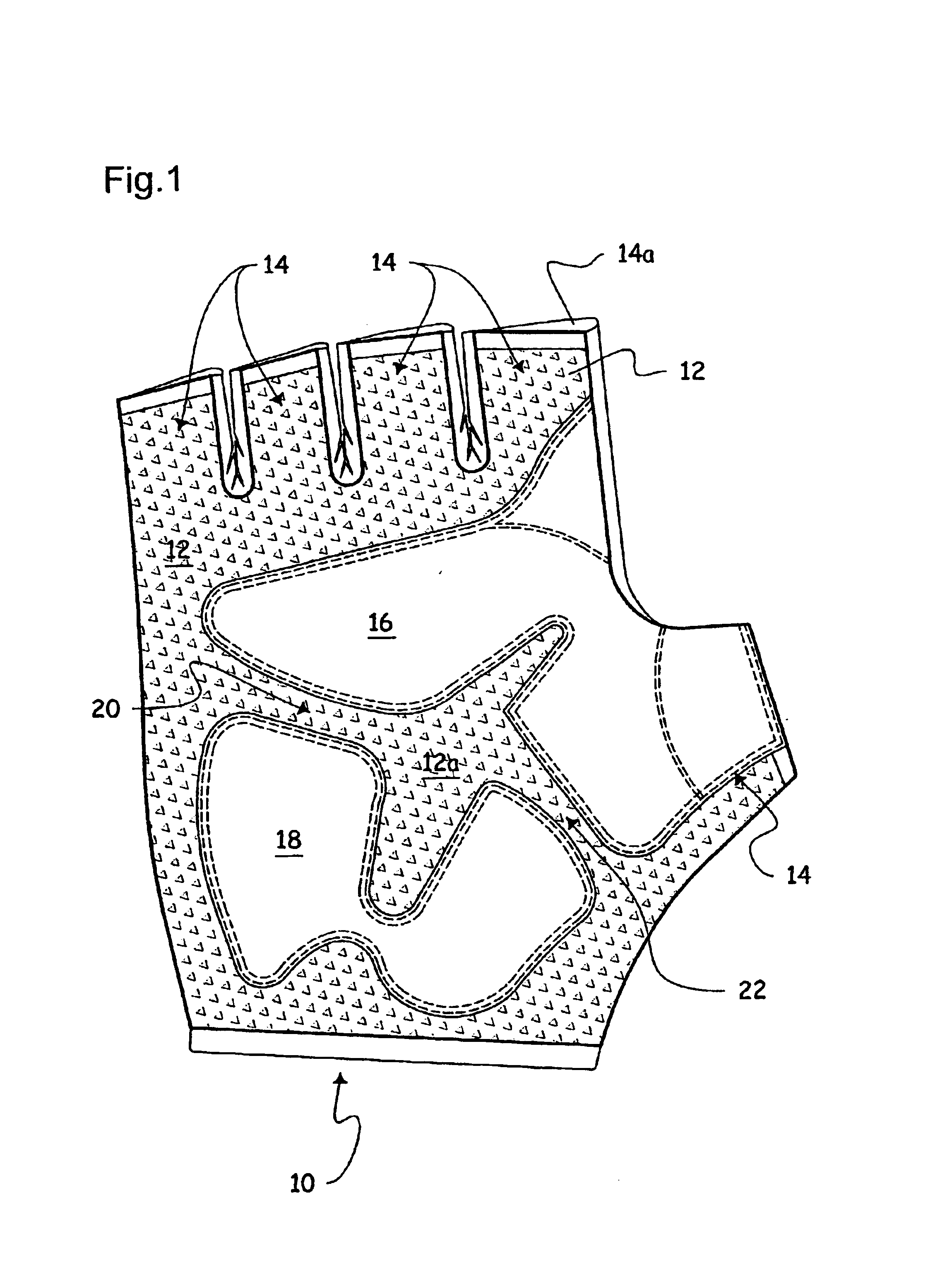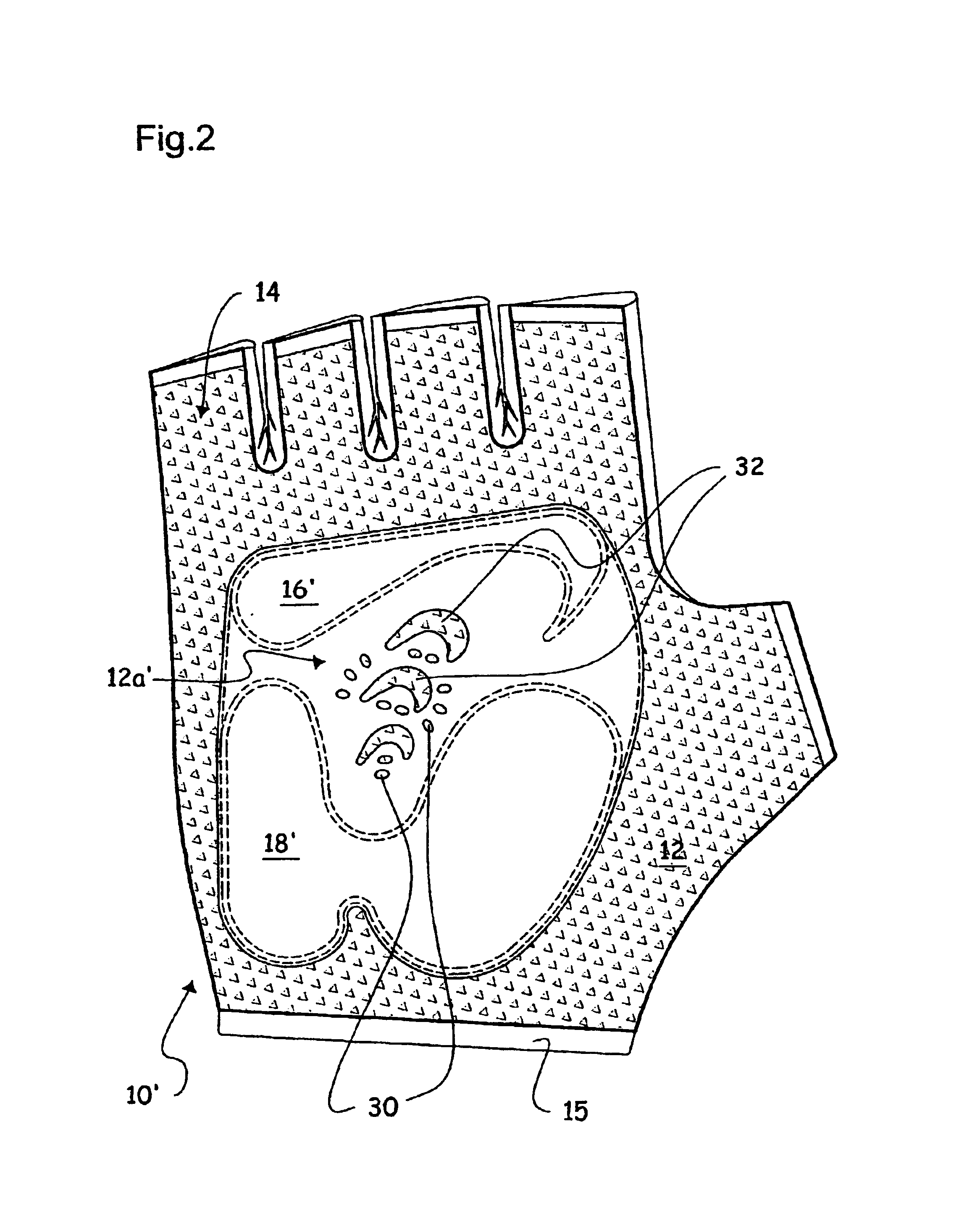High breathability cyclist hand glove
a hand glove and high-breathability technology, applied in the field of cycling hand gloves, can solve the problems of preventing the escape and release of moisture, the most acute moisture build-up, and the increase of body heat and perspiration levels, so as to prevent the sealing of the palm moisture-release perforation, the effect of improving the comfort of cyclists wearing hand gloves
- Summary
- Abstract
- Description
- Claims
- Application Information
AI Technical Summary
Benefits of technology
Problems solved by technology
Method used
Image
Examples
first embodiment
In glove shown in FIG. 1 as 10, two irregularly U-shape thick cushion hand palm pads 16, 18, are mounted onto the main perforated sheet mesh material 12, peripherally to the central mesh portion free of cushion pad, so that an irregularly shaped star shaped mesh section 12a be formed at the palm portion of the hand glove. Star mesh section 12a opens freely at two opposite ends into the main sheet mesh material 12, along air channels 20, 22. It is noted that the width of air channels 20, 22, should be smaller than the diameter of the bicycle handle bar, i.e. that the opposite registering ends of palm pads 16, 18, while being spaced from one another, should be sufficiently close to prevent the bicycle handlebar to enter into contact with the mesh material in either the central palm portion 12a or in air channels 20, 22 when engaging the handlebar. In this way, the air channels 20, 22, remain constantly open, whether the cyclists grasps the handlebar or not, thus ensuring that moisture...
third embodiment
In cyclist glove illustrated as 10″ in FIG. 3, there are provided four quadrangular pads 31, 35, 34, 36, positioned at corresponding corners of the palm area of the glove and spaced from one another. Two separate air channels 38, 40, are therefore formed at right angle to one another, at the palm area in between the respective pads 31, 35, 34, 36. The two air channels 38, 40, define in total four separate moisture escape outlets and / or fresh air intake ports. The main sheet material of glove 10″ inside air channels 38, 40, may or may not be perforated mesh, but preferably include a number of oversized circular apertures 42. The number of apertures 42 may be for example between 10 and 30. Preferably, the two upper pads 31, 35, are smaller in size than the two lower pads 34, 36, for minimizing flexing discomfort when the glove is inserted into a cyclist hand. Again as in the other embodiments of glove according to the present invention, the width of the transverse air channel 38 and t...
fifth embodiment
In glove illustrated as 10″″ in FIG. 5, there are shown an upper rounded rectangular cushion pad 31″, and two lower ovoidal cushion pads 34″ and 36″. A plurality of oversized circular apertures 42″ are made inside the palm area of the glove circumscribed by the three pads 31″, 34″, 36″. Here, three different air channels 50, 52, 54, are formed peripherally in between successive pairs of the pad trio 31″, 34″, 36″. Again, the distance between the top pad 31″ and the two lower pads 34″ and 36″, and thus the width of upper air channels 50, 52, should be smaller than the diameter of the handlebar section onto which the glove wearing cyclist hand is coming in contact, so as to positively prevent accidental sealing of at least a number of the moisture release apertures 42″.
FIGS. 7 and 8 suggest that although the cushioning pads may be partly compressed against the handlebar B by the cyclist hand grasping the handlebar B with glove 10 (10′, . . . ) there remain the air channels 20, 22 that...
PUM
 Login to View More
Login to View More Abstract
Description
Claims
Application Information
 Login to View More
Login to View More - R&D
- Intellectual Property
- Life Sciences
- Materials
- Tech Scout
- Unparalleled Data Quality
- Higher Quality Content
- 60% Fewer Hallucinations
Browse by: Latest US Patents, China's latest patents, Technical Efficacy Thesaurus, Application Domain, Technology Topic, Popular Technical Reports.
© 2025 PatSnap. All rights reserved.Legal|Privacy policy|Modern Slavery Act Transparency Statement|Sitemap|About US| Contact US: help@patsnap.com



